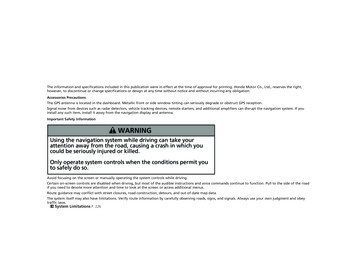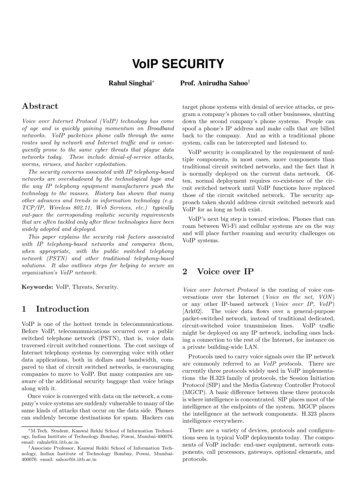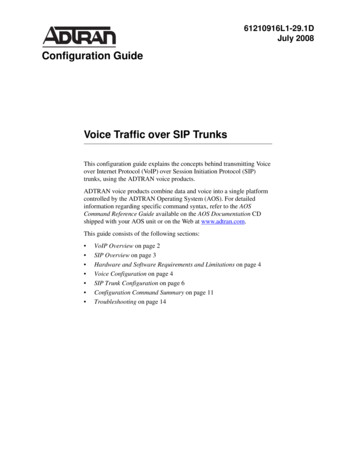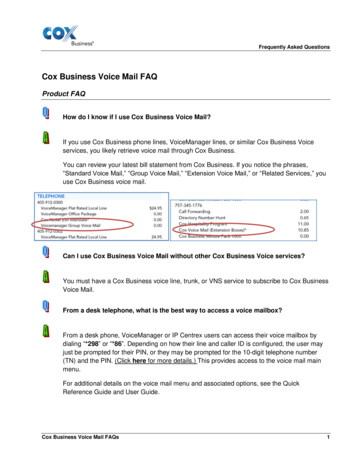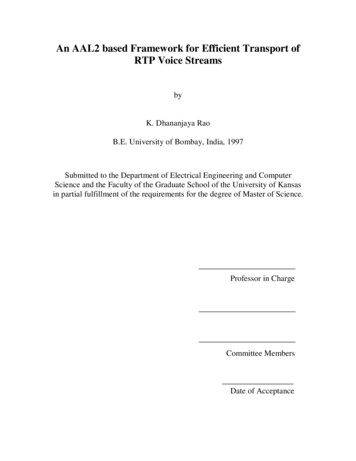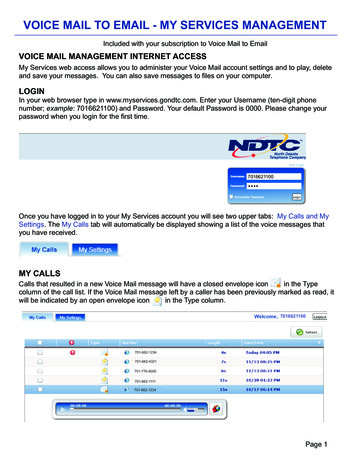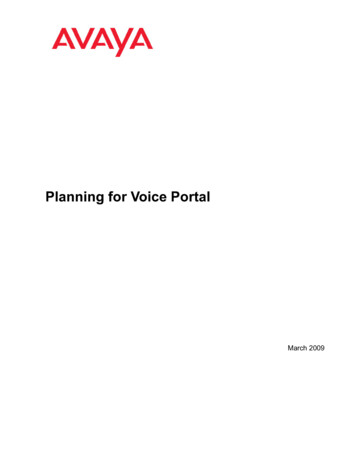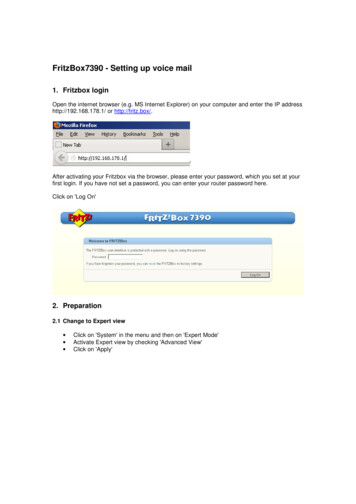
Transcription
Voice over IPVoIPpeteregli.netVOICE OVER IPOVERVIEW OF VOICE OVER IP TECHNOLOGIES,NETWORK ARCHITECTURES AND PROTOCOLSPeter R. Eglipeteregli.net Peter R. Egli 20171/54Rev. 3.30
Voice over 13.VoIP functionsVoice CodecsEcho problem with VoIPVoice Activity Detection / Comfort Noise GenerationJitter inter-packet arrival variationsVoIP relies heavily on DSP technologyTransport of real-time traffic: RTP / RTCP RFC1889H.323SIP Session Initiation Protocol RFC3261MGCP - RFC2705/2805Fax over IPSIP / H.323 / MGCP centralized model vs. Skype peer2peer modelVoIP regulatory issues Peter R. Egli 20172/54Rev. 3.30
peteregli.netVoice over IP1. VoIP functions Signaling comprises all functions to set up, control and teardown a VoIP call/session.Examples of VoIP signaling protocols: H.323, SIP, MGCP, H.248, NCS, Skype. UDP and TCP areused for signaling transport. The data path is responsible for encoding, packetizing and compressing the voice. UDP isalways used for the data path since:a. TCP would introduce too much delay andb. Retransmissions are not necessary and only distort the voice in case of packet loss.Call Setup, Call Control,data path controlSignalingDataPathVoiceIP Peter R. Egli hVoice3/54Rev. 3.30
peteregli.netVoice over IP2. Voice Codecs (1/12) Codec means Coder Decoder. Coding means encoding the (already digitized) voicesamples into a different format, e.g. for compression (reduction of data rate). Digital Voice Transmission Model (PSTN) without igitalsamplesDAnalogvoice Digital Voice Transmission Model (PSTN) with ce samples Peter R. Egli 2017PSTNCompressedvoice samplesCoderADAnalogvoiceUncompressedvoice samples4/54Rev. 3.30
peteregli.netVoice over IP2. Voice Codecs (2/12) Pulse Code Modulation PCM:Sample (measure) amplitude at equal time intervals and encode the amplitudeas digital value.POTS (analog) signal in frequency domain:POTS (analog) signal in time domain:f [Hz]300Hzt [s]3.3kHz1/8000sSampling:The analog signal is sampled at aequi-distant time intervals.The sampling frequency must be at least double the highestsignal frequency (Nyquist theorem: sampling frequency 2*fmax).This means the sampling frequency must be 2*3.3kHz 8kHz.Quantization of samples:The samples are digitized (A/D converter) which results in a stream of 13 (A-law) or 14 (μ-law) bitsamples (voice over analog lines requires 12 bits due to 60dB dynamics power range). Peter R. Egli 20175/54Rev. 3.30
peteregli.netVoice over IP2. Voice Codecs (3/12) G.711 Codec:Output (G.711 values)Input (13/14 bit samples)The G.711 Codec performs compansion (COMPression and ExpANSION) for reducingthe data rate and amplify weak signals in order to increase S/N ratio: Reduction of 13 (A-law) and 14 (μ-law) bits to 8 bits according to a non-linearcompression curve:1. Step: Raise power of weak signals2. Step: Linear quantization A-law and μ-law differ in the compansion curve. G.711 is the standard codec used in PSTNs. Sampling:8kHz sampling rate, 8bits / sample 64kbps channels. Peter R. Egli 20176/54Rev. 3.30
peteregli.netVoice over IP2. Voice Codecs (4/12) Voice Compression Codecs: Purpose of compression: bandwidth reduction. Voice / speech contains a lot of redundancy (same information contained multipletimes); lossy codecs can remove this redundancy whithout reducing the voice quality toomuch (lossy reconstructed signal at receiver ! signal at sender before transmission). Compressing voice codecs use principles like (examples):a. Masking of tones: If 2 tones have almost the same frequency then only the louder toneis audible. Compression removes the masked tone information.f [Hz]1.2kHz 1.205kHzb. Only transmit difference between 2 subsequent voice samples (Differential PCM).Toll quality: Quality good enough to charge money for the service: MOS 4-5; communication quality: MOS 3-4; synthetic quality: MOS 3PCM: Pulse Code ModulationMP-MLQ: MultiPulse-Maximum Likelihood QuantizationADPCM: Adaptive Differential PCMCS-ACELP: Conjugate Structure ACELPACELP: Algebraic Codebook Excited Linear PredictionDSP: Digital Signal ProcessorLD-CELP: Low Delay CELPMIPS: Million Instructions Per SecondVAD / DTX / CNG: Voice Activity Detection / Discontinuous Transmission / Comfort Noise Generation Peter R. Egli 20177/54Rev. 3.30
peteregli.netVoice over IP2. Voice Codecs (5/12) Overview of codecs -qualityYesYes19951990199019921995NoNear tollN/AyesNear tollMOS4.203.653.903.854.003.613.7048 / 56 / S-ACELPAlgorithmic delay [ms]0.125201.530300.1250.1250.625 - 2.510Lookahead delay [ms]0N/AN/A7.57.50N/AN/A5Voice frame 10bytesComplexity [DSPMIPS/RAM/ROM]0.1MIPS2w RAM50w ROM10MIPS256w RAM4kw ROM10MIPS256w RAM4kw ROM18MIPS2.1kw RAM7kw ROM16MIPS2.1kw RAM7kw ROM12MIPS256w RAM12kw ROM12MIPS256w RAM12kw ROM33MIPS3.4kw RAM8kw ROM22MIPS2.5kw RAM9.5kw ROMPass fax/modemYesNoNoNoNoNoNoyesNo1443124432n.a.N/AN/A 3% 3%N/AN/AN/A 5%Yes (annex AN/AYesYesN/AYesVAD / DTX / CNG# of patents / # ofpatent holdersNoNoNoYesYesNoNoNoYesN/AN/AN/A 18 / 8N/AN/AN/AN/A 20 / d highqualitiy VoIPcodec.-Audioencoder-Embeddedversion ofG.726-Std. mediumQ/bit rate VoIPcodec.Bit rate [kbps]Audio bandwidthVBRAlgorithmTandemingPacket loss tolerancePLC Peter R. Egli 2017G.723 .1G.723.119881995YesNear toll4.00N/A64323.4kHzStandard low Standard lowbit rate VoIP bit rate VoIPcodec.codec.G.729A8/54Rev. 3.30
peteregli.netVoice over IP2. Voice Codecs (6/12) Overview of codecs (2):GSM EFRSpeexiLBC ityNear tollNear tollNear tollYesYesMOS3.5 - 3.9n.a.3.4 - 43.79 - 4.14N/A12.22 - 44kbps15.2kbps or 13.3kbps4.75-12.232 - 1283.4kHzN/A3.4kHz3.4kHz20Hz - 20kHzNoYesN/AYesCD-ACELPCELPLPCACELPYesAdaptive time resolutionetc.Algorithmic delay [ms]2030ms (@ 8kHz s. rate)25ms (15.2), 40 (13.3)20ms40ms (end-to-end)Lookahead delay [ms]N/A10ms (@ 8kHz)5ms (20ms frame size)0 (@ 12.2kbps)N/AVoice frame size22.5msN/A30ms (13.3), 20ms (15.2)20ms20msComplexity [DSPMIPS/RAM/ROM]15.4MIPS4.7kw5.9kwVariable22 MIPS 7MIPS18 floating point MIPSPass t loss tolerancen.a.10%Very AYesN/AVAD / DTX / CNGVAD / DTXN/AVAD / DTX / CNGN/A2/20 / 0 (open source)N/AN/A2N/AFreeN/A2 (Polycom & Ericsson)GSMFreeVoIP, online game voicecomm.VoIPGSMVoIP, voice mail-Open source, well suited forVoIP; RFC-Based on Polycom Siren22,G.722.1DateBit rate [kbps]Audio bandwidthVBRAlgorithmVAD / DTX / CNG# of patents / # ofpatent holdersLicenseApplicationComments Peter R. Egli 2017-9/54Rev. 3.30
Voice over IPpeteregli.net2. Voice Codecs (7/12) Overview of codecs (3):Toll quality:Quality for which a toll can be reclaimed.MOS:Mean Opinion Score (quality measure).VBR:Variable Bit Rate.Algorithmic delay: Delay of voice codec algorithm.Lookahead delay: Delay introduced by codec by „looking“ into the following voice frame.Voice frame size: Number of bytes per voice frame (usually a codec processes a voice frameand sends the data as a packet).Complexity:Measure for the complexity of the codec (required processing resources interms of DSP MIPS, RAM, ROM).Pass fax/modem: Ability to pass analog signals like modem and fax.Tandeming:Number of codecs in a row.Packet loss tol.: Impact of packet loss to speech quality.PLC:Packet Loss Concealment (ability to hide packet loss, e.g. by re-playing thelast good packet).Bit-robustness:Ability to conceal bit errors (important on wireless links where the bit errorrate is higher than on wire-based links.VAD / DTX / CNG: Voice Activity Detection, Discontinuous Transmission, ComfortNoise Generation. Peter R. Egli 201710/54Rev. 3.30
Voice over IPpeteregli.net2. Voice Codecs (8/12) Codec technology (1):Waveform coders: Send directly voice samples or sample differencies. Background noise is also coded and sent to receiver. Such coders usually provide high voice quality. High bit rate ( 16kbps). Waveform coders work in the time domain.Vocoding: The encoder builds a set of parameters from voice, derives the perceptualfeature of the voice and sends the parameters to the receiver. The receiver has a synthesizer and reproduces the original voice based onthe parameters received. The reproduced voice sounds „synthetic“ and is not good enough for telephony. PBX systems sometimes employ Vocoders for storing messages. Very low bit rates (1.4kbps). Vocoders work in the frequency domain.Hybrid coders: Mixture of waveform coders and vocoders. Operate from 4kbps to 16kbps. Peter R. Egli 201711/54Rev. 3.30
peteregli.netVoice over IP2. Voice Codecs (9/12) Codec technology (2):Bit rate versus quality:PCM based codec‘s speech quality deteriorates with higher compression ratio.Narrowband speech coders are able to maintain a high level of speech qualityover a wide range of compression ratios (bit rates).MOSWaveform codingHybrid codingVocoding5Toll quality: MOS 44Narrowband speechcodingPCM32Bit rate [kbps]6432168421MOS: Mean Opinion Score; speech quality assessment by representative group of people. Peter R. Egli 201712/54Rev. 3.30
peteregli.netVoice over IP2. Voice Codecs (10/12) Characteristics of voice coders (1): a. Bit rate (usually higher compression results in lower voice quality). b. Complexity of the coding algorithm (MIPS required to process the voice): High complexity higher costs (more powerful and more expensive DSP). High complexity higher power consumption. High complexity higher delay.Codecs require 10.20MIPS (per voice channel). c. Delay: How much delay is acceptable? ITU-T G.113 / G.114 states that max. 150ms delay in 1 direction for acceptable quality. Satellite delay: 250ms uplink, 250ms downlink 500ms end to end delay. Factors that contribute to delay:DCoderAVoice frame Peter R. Egli 2017Frame buffer13/54Rev. 3.30
peteregli.netVoice over IP2. Voice Codecs (11/12) Characteristics of voice coders (2): c. Delay (cont‘d): Delay on low speed links:E.g. on a link with 256kbps a 1500 bytes data packet takes 40ms for transmission;during the data packet transmission, the voice frame is blocked (queued)for transmission thus introducing delay.Solution: fragmentation of large (data) frames.Without fragmentation:VoiceJumbo data packetFrame bufferTransmission lineJumbo data packetVoiceJumbo data packetWith fragmentation: Peter R. Egli 2017VoiceDataVoice14/54Rev. 3.30
Voice over IPpeteregli.net2. Voice Codecs (12/12) Characteristics of voice coders (3): d. Quality:How can quality be measured?a. Objective measurement (harmonics distortion, S/N):E.g. P.862/PESQ (Perceptual Evaluation of Speech Quality).Problem: objective measurements do not correlate well with subjectiveassessment of voice quality.b. Subjective measurement („how good does it sound“):E.g. MOS Mean Opinion Score: Assessments are carried out by a group of people.MOS scale:5 excellent (HiFi).4 toll-quality (G.711, PSTN standard quality).1 lowest (poor) quality. e. Error tolerance (susceptibility to packet loss):Codecs that use entire frame for voice compression (and even look-ahead) aresusceptible to packet loss („resync“ DSP).Solution: E.g. G.729 error concealment: replay last packet if current packet lost.Packet loss tolerance is expressed in [%], e.g. G.729 max. 5% packet loss.Packet loss in the Internet is a real problem, see e.g.http://www.internettrafficreport.com/ Peter R. Egli 201715/54Rev. 3.30
peteregli.netVoice over IP3. Echo problem with VoIP (1/5) Echo in traditional PSTN (Echo exists also in PSTN):Echo (reflection) occurs in hybrid circuit (impedance mismatch) and handset (coupling ofloudspeaker signal to microphone).ISDN phones have separate receive and transmit paths and thus do not need a hybrid circuit;but ISDN phones, like analog phones, have acoustic echo in hands-free mode.4 wires2 wires2 wiresPhoneAcoustic Echo inhandset andecho in hands-freemode.PhoneHybrid2w/4w circuit inCentral Office.Electric Echo (Hybrid Echo)Hybrid2w/4w circuit inCentral Office.Electric Echo (Hybrid TtransmissionΔTtransmissionTime Peter R. Egli 201716/54Rev. 3.30
peteregli.netVoice over IP3. Echo problem with VoIP (2/5) Echo types:Echoes (reflections) occur at different points in the transmission path. Echoes are againreflected at these points but are also dampened (amplitude reduced).Talker echo:Echo that talker hears (his own voice).Listener echo:Echo of talker signal that listener hears.Remote talker echo:Echo of talker signal that talker hears but that is generated at the farend.4 wires2 wires2 wiresPhonePhoneTalker EchoListener EchoRemote Talker Echo Peter R. Egli 201717/54Rev. 3.30
peteregli.netVoice over IP3. Echo problem with VoIP (3/5) Solution: Echo Canceller which cancels near-end echo for far-end.Each side of a speech connection cancels the locally generated echo for the far side.The echo canceller must find out the delay between signal and its reflections. The delay of theecho canceller is then configured with this measured delay.This delay is continusuously adjusted during a speech conversation. Additionally the echocanceller must also be able to handle multiple echoes (reflections) and even echoes of echosignals.Echo tail: time that signal needs to travel from echo canceller to point of echo and back toecho canceller; typical tail length of echo cancellers are 32ms and 64ms (maximum delay anecho canceller can handle).4 wires2 wiresΔPhoneHybrid2w/4w circuitCentral Office Peter R. Egli 2017-Delay(samplestorage)SubtractorEcho cancellerInput speechsignalOutputsignalwithout echo18/54Rev. 3.30
peteregli.netVoice over IP3. Echo problem with VoIP (4/5) 2 factors contribute to the echo problem:a. Signal reflections (hybrid, acoustic).b. Transmission delay. Thus the echo problem depends on the transmission delay whichcan not be controlled (satellite links, long haul transatlantic lines). Echo cancellation needs to be done at long delay lines‘ ingress points.Satellite uplink / downlinkPSTN Peter R. Egli 2017EchoCanc.Long haul linehigh delayEchoCanc.PSTN19/54Rev. 3.30
peteregli.netVoice over IP3. Echo problem with VoIP (5/5) When to use echo cancellers:Rule of thumb: If network delay exceeds 30ms.50ms, echo cancellers need to be used. 10ms RTT:Echo not audible.10-30ms RTT:„Tunnel sound“, but communication possible without echo cancellers. 30ms RTT:Not ok, echo cancellers must be used. PSTN (POTS, analog):Very low transmission delay, thus (almost) no echo problem. ISDN:Transmit and receive path are separated (because it is digital), thus no echo is present(except acoustic echo in hands-free mode). Satellite links:Typically 250ms uplink and 250 downlink, thus echo cancellers needed. VoIP:Considerable delay (in packet network), thus need to cancel echo generated in PSTN (echocanceller removes echo produced in PSTN for VoIP client).PSTN Peter R. Egli 2017GatewayEchoCanc.VoIP20/54Rev. 3.30
peteregli.netVoice over IP4. Voice Activity Detection / Comfort Noise Generation (VAD / CNG) Voice data rate reduction through silence suppression:In a (reasonable) conversion at most 50% of the bandwidth is used (usually one party is silentwhile the other speaks). With VAD voice packets are only sent if there is speech thus savingbandwidth.VAD thresholds Problems of VAD:1. Hangover:Codec remains active for some time (typ. 200ms) after voice level has fallen below threshold.2. Front end clipping:VAD needs some time to detect if signal amplitude has exceeded thethreshold. The first syllable may be cut off („Meier Eier“ problem).3. Silent periods:Silent periods are very disturbing during a conversation (line appears to be „dead“). ComfortNoise Generation (CNG) produces an artificial background noise so that the line does notappear to be dead. CNG measures the background noise level and spectral distribution andtransmit this information to peer which plays back the noise signal. Peter R. Egli 201721/54Rev. 3.30
peteregli.netVoice over IP5. Jitter inter-packet arrival variations Control of packet spacing at the receiver:The receiver must make sure that the voice decoder or phone never has a packet underrun(no packets to play back).VoIPSenderReceiverVoice packets nicely spaced(traffic shaping).Packet networkintroduces non-uniformdelay.Packets arrive at destinationwith uneven delays.VoIPPhone hasbuilt-indejitter buffer The dejitter buffer stores packets and replays them evenly towards the speaker thus ensuringthat there are no dropouts.But: The dejitter buffer introduces additional delay! Peter R. Egli 201722/54Rev. 3.30
peteregli.netVoice over IP6. VoIP relies heavily on DSP technologyWho‘s doing all the coding, echo cancellation, voice activity detection, fax/modemdetection/modulation etc.? DSP Digital Signal Processor.The DSP digital signal processing is mainly MAC: Multiply ACcumulate operations.E.g. Finite Impulse Response filter (FIR):YN XN * C1 XN-1*C2 XN-2*C3 . X0*CN The DSP is optimised for these calculations (harward architecture).0100101101001.(voice sample stream).11010010.(compressed voice)Data RAM(coefficients and samples)C (coefficient)InstructionRAM(software,program)X (sample)xControlAccumulator Data Path Peter R. Egli 201723/54Rev. 3.30
peteregli.netVoice over IP7. Transport of real-time traffic: RTP / RTCP RFC1889 (1/2) Almost all VoIP protocols (H.323, SIP, MGCP, Skinny) use RTP over UDP for the transport ofvoice or video. RTP does not itself provide real-time characteristics. Instead it transports information thathelp the application achieve real-time behavior.RTP: Real Time traffic Transport Protocol functions:1. Sequencing (SN) (reordering of voice packets).2. Time stamping (dejitter buffer control).3. Payload type (PT) indication (which codec was used for voice in RTP packet).4. Multiplexing (SSRC) (indication of source in case of conferencing).5. Layer 4 framing (M) (indication of video frame).RTCP: Real Time Transport Control Protocol functions:1. Long term delay and packet loss statistics (5s).2. Quality monitoring.RTP protocol stack:Voice FrameData (voice samples or compressed voice)RTPUDPSSRCIPEthernet / Frame Relay / ATM Peter R. Egli 2017Time StampV 2 P ECCMPTSN24/54Rev. 3.30
Voice over IPpeteregli.net7. Transport of real-time traffic: RTP / RTCP RFC1889 (2/2) RTP uses UDP:TCP retransmissions would garble the voice. Voice must be delivered to the loudspeaker asquickly as possible. TCP retransmissions introduce (variable) delay. Timely delivery is moreimportant (UDP) than error-free delivery (TCP) as long as the error rate is below an acceptablelevel. RTP has a high overhead:12 bytes RTP 8 bytes UDP 20 bytes IP 40 bytes headersE.g. G.729 with 10 bytes payload 80% overhead!Overhead can be reduced with compressed RTP (cRTP): 40 bytes are compressed to 4 bytes (with UDP checksum); 40 bytes are compressed to 2 bytes (without UDP checksum).But: cRTP is only possible on point to point links (since IP header is compressed). RTCP may be used for long term traffic monitoring (5s between RTCP reports between 2RTP endpoints). But RTCP is usually not used to monitor voice quality. Peter R. Egli 201725/54Rev. 3.30
peteregli.netVoice over IP8. H.323 (1/8) H.323 ITU-T „all in one“ protocol suite for voice, data, fax and video over IP. H.323 is not aprotocol but a protocol suite (also called „umbrella standard“). H.323 Protocol components and protocol stacks:H.450H.235H.225.0Annex LH.225.0 H.225.0Annex K Annex GH.235H.235H.245H.225.0–Q.931Audio / PUDPIPData link layerPhysical layer H.225.0-Q.931: H.245: H.225.0-RAS: H.235: H.450: T.120/T.12x: T.38: Peter R. Egli 2017Call signaling protocol (similar to Q.931 in ISDN).Logical channel (data/media channel) control protocol for set up and teardown media (voice) channels.Registration, Admission, Status (registration with central gatekeeper).Security (message data integrity, authentication, privacy).Supplementary services for H.323 (CF, CW, 3PTY).Data sharing (data, video).Fax over IP.26/54Rev. 3.30
peteregli.netVoice over IP8. H.323 (2/8) H.323 Components (1):IP (H.323)H.323 GatekeeperH.323 proxyIP(e.g. LAN)PSTNH.323 gatewayH.323 terminal(soft client)H.323 terminal(IP phone)MCUH.323MPH.323MCGatekeeper ( RAS Server):All devices (clients, gateways, MCU) register with gatekeeper. For each new call the clientscontact the gatekeeper for address resolution. The gatekeeper mainly has following functions: Access Control (who is allowed to place calls and to whom). Registration (of phone number and according IP address). Address Translation (phone number to IP).N.B.: H.323 also allows direct signaling between clients without a gatekeeper in between („gatekeeperless signaling“). Peter R. Egli 201727/54Rev. 3.30
Voice over IPpeteregli.net8. H.323 (3/8) H.323 Components (2):MCU: Multipoint Control Unit (MC n*MP):Conferences between 2 parties need a multipoint unit for mixing the voice streams so that eachparty can hear all other conversation partners. The MCU consists of a control unit(Multipoint Controller MC) and 1 or many MPs (devices that actually mix audio streams for aconversation). The MPs are either specialized hardware devices with DSPs or powerful generalpurpose processors.H.323 gateway:The gateway interfaces the H.323 network (IP) to the PSTN (packet to circuit conversion). It consistsof a signaling gateway (e.g. H.323 to ISDN signaling) and a data path gateway (e.g. RTP G.723 to G.711transcoding).H.323 Proxy:Proxies allow to connect an internal H.323 network (private) to an external H.323 network (public). Inaddition proxies afford firewall functionality (firewall for H.323 services).H.323 Terminal:Either softphones (soft clients) or hardphones. Peter R. Egli 201728/54Rev. 3.30
peteregli.netVoice over IP8. H.323 (4/8) Signalling (terminal to terminal) (1):Message flow for direct signaling between 2 H.323 clients.IPH.323 terminal (A)H.323 terminal (B)Create TCP connection for H.225.0-Q.931SETUP (A calls B)Phase 1CALL PROCEEDINGALERTING (B is ringing)CONNECT (B hooked off)Phase 2Create TCP connection for H.245 signallingH.245 signallingRTP (voice, video, fax)RELEASE COMPLETE (A releases call)Release TCP connection for H.245Release TCP connection for H.225.0-Q.931 Peter R. Egli 201729/54Rev. 3.30
Voice over IPpeteregli.net8. H.323 (5/8) Signalling (terminal to terminal) (2):H.323 signalling phase 1:H.225.0-Q.931 protocol messages are used for call setup (setup, alerting, disconnect).As its name implies this protocol is very similar to the ISDN signalling protocol ( Q.931).H.323 signalling phase 2:H.245 data channel signalling capability exchange (similar to PPP LCP) where each peer tellsthe other its capabilities. The 2 parties agree on the set of capabilities (codec to be used, VADetc.) for the session.If both parties disagree on media channel settings one party becomes master and resolves theconflict (Master slave determination).The media channel characteristics may be changed during the call (optional mode requestprocedure), e.g. change of codec for a fax transmission (see below). Peter R. Egli 201730/54Rev. 3.30
peteregli.netVoice over IP8. H.323 (6/8) Addressing:H.323 supports multiple classes of addresses: E.164: International PSTN phone number. E-Mail address („user@company.com“). URL (H323://user1@isp1.com). IP address (some IP phones, e.g. NetMeeting can be addressed by an IP address). String, alias name.At startup H.323 clients (phones, gateway, MCU) register their addresses, aliases etc. with thegatekeeper.AliassupermanbatmanH.323 Gatekeeperwith lookup table043 876 12 43PSTNIPH.323 gateway193.5.54.119 Peter R. Egli 2017Mail addr.E.164IP0438761243 24nobody@abc.com“batman”193.5.54.2031/54Rev. 3.30
peteregli.netVoice over IP8. H.323 (7/8) H.225.0 RAS (1):After startup H.323 clients register at the gatekeeper with the H.225.0 RAS protocol.The gatekeeper talks to backend servers through other protocols (e.g. RADIUS).RAS provides the following services:a. Address resolution.b. QoS (bandwidth allocation).c. AAA services (Authentication, Admission, Accounting).Backend(gatekeeper to RADIUS andother servers)AAARADIUSFront-End (client to gatekeeper)H.225.0-RASAuthenticationServerUser PolicyServerH.323 terminal(soft client)QoS PolicyServerE.164 IPURL IP (DNS)Alias IP (LDAP)Adress Res.ServerRADIUSAccountingServer Peter R. Egli 2017IPH.323 GatekeeperH.323 terminal(soft client)32/54Rev. 3.30
peteregli.netVoice over IP8. H.323 (8/8) H.225.0 RAS (2):RAS messages:Gatekeeper Discovery (find gatekeeper):Gatekeeper Request GRQGatekeeper Confirm/Reject GCF/GRJH.323GatekeeperH.323 terminal(soft client)GRQGCFGatekeeper Registration (register with gatkeeper):Registration Request RRQRegistration Confirm/Reject RCF/RRJRRQAdmission Request (for each call):Admission Request ARQAdmission Confirm/Reject ACF/ARJARQBandwidth Request (optional, request BW for call):Bandwidth Request BRQBandwidth Confirm/Reject BCF/BRJDisengage Request (at end of call):Disengage Request DRQDisengage Confirm DCFUnregister Request (un-register with gatekeeper):Unregister Request URQUnregister Confirm/Reject UCF/URJ Peter R. Egli 2017RCFACFBRQBCFDRQDCFURQUCF33/54Rev. 3.30
peteregli.netVoice over IP9. SIP - Session Initiation Protocol - RFC3261 (1/8) SIP Components (1):A SIP network consists of:a. SIP User Agents (clients, phones)b. SIP servers (SIP proxy server, redirect server, registration server)A user agent UA is a SIP client. However SIP servers (proxy server, registration server) alsocontain the UA functionality.SIP registrationserver (registrar)IP (SIP)SIP proxyserverIP(e.g. LAN)PSTNSIP gatewaySIP redirectserver Peter R. Egli 2017SIP User Agent UA(soft client)SIP User Agent UA(IP phone)SIP locationserver34/54Rev. 3.30
Voice over IPpeteregli.net9. SIP - Session Initiation Protocol - RFC3261 (2/8) SIP Components (2):SIP Gateway:User Agent that connects SIP to other protocols (like ISDN).SIP User Agent UA:SIP-enabled endpoint. Device that can send and receive SIP INVITE and ACK messages.A UA consists of a UA client (UAC) and UA server (UAS) akin to email client.SIP Proxy Server:SIP enabled device that acts both as SIP server and client. A SIP proxy server receives aSIP request (thus acting as SIP UA server), performs some application-specific action onthe SIP message (e.g. changing the URLs) and forwards the SIP request to another SIPserver (thus acting as SIP UA client).SIP Redirect Server:SIP server that accepts a SIP request, maps the incoming address to one or more newaddresses and returns these new addresses to the requesting SIP client.Unlike a SIP proxy server does initiate SIP requests on its own but only redirects arequesting client to another server.SIP Registration Server (Registrar):A server that accepts SIP REGISTER messages. The registrar stores the addressinformation in a location service via a non-SIP protocol (e.g. LDAP).SIP Location Server:A non-SIP device that is accessed by SIP redirect servers and SIP registrars. SIP locationservers are used for address resolution (URI). Peter R. Egli 201735/54Rev. 3.30
peteregli.netVoice over IP9. SIP - Session Initiation Protocol - RFC3261 (3/8) SIP session setup (1):Call setup using SIP Direct Mode (address of callee known to caller):alice@[20.30.40.50]1INVITE 200 OKACK bob@[100.110.120.130]Alice sends an INVITE message to Bob.Bob accepts the call and responds with code 200 OK.Alice acknowledges with an ACK message.Both Alice and Bob open the data path (RTP) and start the conversation. Peter R. Egli 201736/54Rev. 3.30
peteregli.netVoice over IP9. SIP - Session Initiation Protocol - RFC3261 (4/8) SIP session setup (2):Call setup via SIP Proxy Server:alice@[20.30.40.50]SIP Proxy Serverfhzh.ch1INVITE bob@fhzh.ch6 200 OK, Contact jim@students.fhzh.ch72where is bob@fhzh.ch ?Location Server3 bob registered as jim@studentsACK jim@students.fhzh.chbob@fhzh.chjim@students1. Alice sends an INVITE message to fhzh.com server (which acts as proxy server).2./3. The proxy server looks up bob in its location server (through a non-SIP protocol likeLDAP) and determines that bob is registered as jim@students.4. The proxy server constructs a new URL jim@students.fhzh.ch and sends the INVITEmessage to Bob’s PC (or SIP phone).5./6. Bob accepts the call and sends back an ACK message to the proxy server which inturn sends it to Alice.7./8. Alice acknowledges with an ACK message (sent to the proxy server and from there tobob. Peter R. Egli 201737/54Rev. 3.30
peteregli.netVoice over IP9. SIP - Session Initiation Protocol - RFC3261 (5/8) SIP session setup (3):Call setup via SIP Redirect and SIP Proxy Server:alice@[20.30.40.50]SIP Redirect Serverfhzh.ch1INVITE bob@fhzh.ch4 302 Moved temporarily; Contact bob@ethz.ch52fhzh.chwhere is bob@fhzh.ch ?3Location Serverbob is bob@ethz.chACK bob@fhzh.chSIP Proxy Serverethz.ch78where is bob@ethz.ch ?ethz.chLocation Serverbob registered as jay@studis1.Alice sends an INVITE message to fhzh.comserver (which acts as redirect server).2./3./4./5. The redirect server ascertains that Bob hastemporarily moved and send a
Voice over IP peteregli.net Digital Voice Transmission Model (PSTN) without Codecs: A D 2. Voice Codecs (1/12) Codec means Coder Decoder. Coding means encoding the (already digitized) voice samples into a different format, e.g. for compression (reduction of data rate). Digital samples Digital Voice Transmission Model (PSTN) with Codecs .
